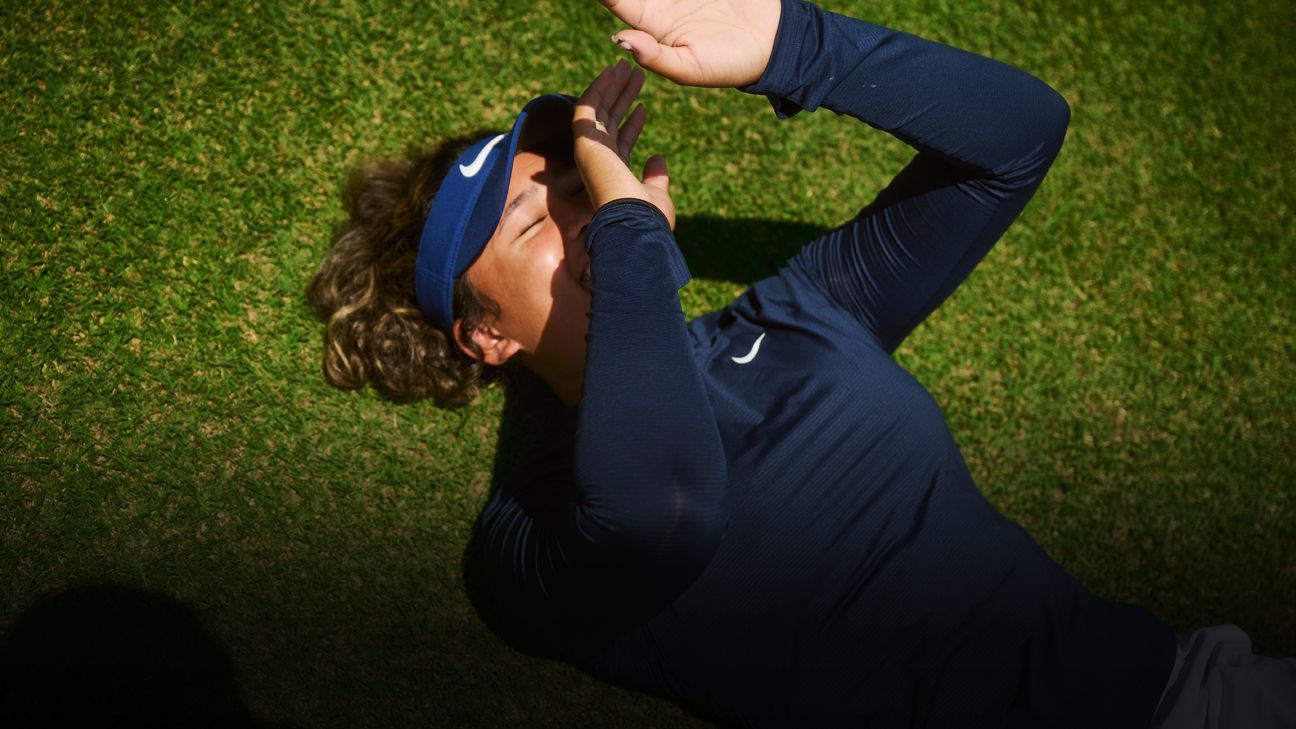How Amari Avery, the ‘next Tiger Woods,’ drove her own dream
AMARI AVERY IS frustrated. It’s her first hole of the day, and her drive on the par-4 10th hole at Rancho Santa Fe Country Club in California has fizzled barely 150 yards along the right rough. Now she stands behind her golf ball, lodged deep in the six-inch-long grass, more than 165 yards from the green, positioned behind a tree. She shakes her head, throws up her arms and chuckles.
“I completely mishit it,” Avery says. “All I could do was laugh.”
Today is June 5, also known as the “longest day in golf,” when hundreds of amateur and professional golfers tee it up for 36 holes of stroke play to qualify for the U.S. Open and the U.S. Women’s Open. This year’s U.S. Women’s Open, starting July 6, will be staged for the first time at Pebble Beach Golf Links, the famed course where some of golf’s greatest names, such as Jack Nicklaus, Tom Watson and Tiger Woods, have been crowned champion. But there are only two spots available at this qualifying tournament, and Avery must beat out 62 competitors today for one of them.
“It’s a pretty big deal,” Avery says. “I’m trying to just play my game. Not put pressure on myself.”
Avery knows something about the price of pressure that many of her rivals don’t. She has been competing in tournaments since she was 8 and was deemed a prodigy before she could do long division, thanks in part to her father, Andre Avery, who signed her up for documentaries like Netflix’s “The Short Game” and HBO’s “State of Play: Trophy Kids,” both released in 2013. Andre even nicknamed her “Tigress,” because of her similarities to Woods, from her big drives and competitive fire to their shared Dec. 30 birthday and backgrounds: Her father is Black and her mother is Filipino (Woods’ father is Black and his mother is of Thai descent).
In no small part owing to those similarities, Avery has been told by family, friends, coaches and even strangers since childhood that she was destined to be one of the best golfers in the world. But, at 19, the stark reality is that the USC sophomore is not Tiger Woods, and she’s not college phenom-turned-pro Rose Zhang. She is the No. 10-ranked amateur player, trying to become more than just a talented golfer on the fault line of success, fighting to figure out if she has what it takes to join the LPGA.
That fight has brought her here today, to the 11th hole at Rancho Santa Fe Country Club, where she pushes her tee into the grass, ready to redeem herself after her first drive. Gray clouds fill the sky above her. She slightly lifts her white visor from her forehead to allow more light to peek in, and gazes down the fairway of the 433-yard par-5, her blank canvas. Finally, after a beat, she swings, but her driver makes imperfect contact with the ball. Another mishit.
“What is happening?” Avery shouts.
AVERY STARES AT the practice putting green at her local golf course in Orange County, California. Four golf balls are spread out at various angles. The target is one cup, 10 feet away. It’s 2012, and she’s only 8 years old, but she’s done this drill enough times already to know that she doesn’t like it. Andre, her father, wants her to make all four putts consecutively.
When her father walks to the clubhouse to grab some water, Avery rushes over to the cup and taps them all in. When he walks back outside, Avery cheers, and puts on her biggest grin. “Dad, I did them all,” she tells him.
Andre looks at her, and says, “Really?” He had been watching her from inside the whole time. Pulling her off to the side of the green, Andre gazes at his daughter and sternly asks: “Do you want to be the best?”
Shrugging her dad’s words off, Avery grabs her putter and returns to the starting line on the putting green. For another hour, Avery putts to the tees until she makes them all.
“I tried to take the easy way out,” Avery says now. “Ever since then, I just realized that there’s no shortcuts to hard work and being successful. I go back to that drill all the time and it reminds me to just keep going, keep persisting, trying to be the best.”
From the time she picked up her first golf club at 4, the idea of being “the best” surrounded her. Andre remembers how she would try to hit a wiffle golf ball over the couch in her family’s living room, failing, failing, failing, until one day the preschooler did it, hitting the back wall. “Boom. Her eyes just lit up,” says Andre, a recreational weekend golfer. “And that right there, I was like, ‘OK. OK. We might have something here.'”
Before kindergarten, Avery started golf lessons with a local pro in Anaheim. By age 6, she had won dozens of youth golf tournaments, including the junior world championship. That’s when Andre provided her with her Tigress nickname. “I thought she was Tiger Woods at 6,” he says.
Andre was far from an expert at the game, and his wife, Maria, knew even less. And so Andre looked to Woods’ father, Earl, for the blueprint. “I was amped up,” Andre says. “I started reading Tiger Woods’ books about training and learned about what Earl did, and I just followed his footprint there.” How, he felt, could he ignore the signs? The shared birthdays, the shared background, the fact that they both grew up in Orange County, that they both got their first hole-in-one at Heartwell Golf Course in Long Beach? For Andre, it all felt “divine.”
Just as Earl Woods did for his son, Andre wanted his daughter to understand that sports and entertainment were tethered and that showcasing emotions on the course is a part of the game. “I like to call it opening Pandora’s box, right?” Andre says. “Because once you open it, there’s no closing it. She had something special, and I wanted the world to know about it.”
The world soon would, through the 2013 documentaries “The Short Game” and “State of Play: Trophy Kids,” both of which chronicled the lives of sports prodigies. In both, Avery was introduced as Tigress. “I thought it was cool to be called Tigress,” Avery says. “I just felt like it was a separate personality, you know? It was kind of like my golf personality. Like Amari was just a fun kid. She went to elementary school, and then when I played in the world championships, I was Tigress. I was someone completely different.”
In many scenes, Tigress can be seen flashing a big smile and laughing, only to be in tears or stomping her feet after mishits and missed putts moments later. Always nearby, cameras also captured Andre in what he describes as a “bad light,” cursing and reprimanding his daughter.
“It showed me how to grow up,” Andre says. “It showed me how to grow with my child in the game and not be so pressurized all the time. I kind of wish more parents could see themselves in that light … I’m being a hard parent, but I think it takes some of that too, right? People don’t see, you know, that leads to greatness.”
In the years following the documentaries, Andre quit his job in tech and stayed home with Avery and her younger sister, Alona, to focus on making them elite amateur golfers. While Maria worked in Los Angeles, Andre divided the girls’ days into golf and schoolwork. “I really just trusted his instincts,” Maria says. Those instincts included the decision to homeschool the girls after Avery finished fifth grade, at which point Andre made it clear to both his daughters that the goal was for them to become professional golfers in the near future.
“When we started homeschool, that kind of shifted the importance and the focus on golf a lot more,” Avery says. “I didn’t have time to be a kid. But that’s the sacrifice I made to try and be the best. You have to put in the hours, and you have to get ahead of everyone.”
Members at their golf club started questioning Andre and his parenting and coaching styles. “I heard people say to him, in front of me, ‘You know, you’re going to burn her out. She’s going to burn out,'” Avery says. “And every single time, his response would be, ‘She’s not going to burn out. Burn out? That doesn’t exist in our vocabulary.'”
“This is what we signed up for,” Avery continues. “My dad, my family, we’ve always had this goal of wanting to be the best in the world. And people aren’t going to like that. Some people are going to be like, ‘Why don’t you just let her be a kid? Why don’t you just let her go to school?'”
Avery started asking questions of her own right before high school. The time spent practicing on the range, traveling to golf tournaments, following another athlete’s blueprint — all of it started to feel like a duty rather than a dream. And it was showing in her game; her struggles left her feeling like she was no longer the best.
One day in 2018, a year after Avery won the American Junior Golf Association’s Callaway Golf Junior Championship — her last big victory on the prestigious junior golf tournament circuit — she finally confronted whether she loved the game enough to pursue it at all costs. She had traveled 45 minutes to Bear Creek Golf Club in Murrieta with her father and sister, as she did most days. She grabbed her clubs from the car and walked straight to the driving range. Avery gazed down at the dozens of golf balls on the grass. Her once-fluid swing felt foreign; she was on the verge of tears as she hit ball after ball, every one feeling like a mishit. Finally, she wiped away the sweat from her forehead and took a beat. In that moment, she knew she had a choice to make. “What do you want? What is your dream? Who do you want to be?”
Then she started to feel a sigh of relief — it all clicked. Since she was 4, she’d been chasing after a dream designated to her by her father. By age 8, she became known as Tigress. But now, at 14, she was ready to fully let go of the nickname, and to separate herself from the blueprint. That day on the range, she decided to own the dream for herself.
“I really found a love for the game when I wasn’t playing my best,” she says. “I really thought to myself, ‘I love this game. This is what I’m going to keep doing.’ It’s hard, but that’s just life in general.”
SWEAT ROLLS DOWN Avery’s forehead. It’s 100 degrees on the third day of the NCAA Division I Women’s Golf Championship at Grayhawk Golf Club in Scottsdale, AZ, and Avery is 3-under after her first two rounds. That’s left her just two strokes back from Rose Zhang and only a few strokes from the top of the leaderboard. What Avery does on this late-May day will determine whether she has a chance to claim the NCAA Division I Women’s Golf individual title and an exemption into the U.S. Women’s Open.
After carding zero bogeys during her second round, Avery starts the front nine with three bogeys in the first six holes. Every opportunity she has to save par or make a birdie quickly fades when her putter fails to deliver on the greens.
After missing a critical birdie putt on the 15th hole, Avery puts her head down and walks to the par-3 16th. She moves underneath her oversized golf umbrella, sticking out of her pushcart, and tries to navigate away from her playing partners. She knows what’s about to happen and can’t stop it. Her associate coach, Tiffany Joh, walks toward her. Avery holds both hands to her face. The glitter that she applied to her cheeks before the round, in an attempt to bring a little levity to the moment, is no longer visible. Tears trickle down her face. Joh gently grabs her right arm and whispers, “It’s OK. Take a deep breath. It’s OK. You can do this.”
Avery pulls out her club and walks toward the tee box. Each step, she closes her eyes. Trying not to cry again, Avery hits the ball. Her once-smooth swing looks discombobulated. She drags her club down and raises her head toward the sun. She thinks to herself, “Just finish these holes and be done.”
On the 18th hole, Avery slowly walks down the fairway with her head hanging low. Exhausted from a grueling day on the greens, she’s ready to finish her round. She makes her par putt — the first par putt she has made in three holes. Her teammates and competitors sit in Adirondack chairs with umbrellas propped up above them, watching the scene unfold on the final hole. Avery forces a slight smile after her last putt drops.
“She has that fire inside of her,” USC head coach Justin Silverstein says, “but what we’ve worked on is really trying to control that. She’s got a long career ahead of her, and you don’t want to burn out too quickly.”
Avery’s father and sister watch about 20 yards from the green. Alona shakes her head and says, “Let’s hope tomorrow is better.” Andre doesn’t speak.
After signing her scorecard, Avery rushes over to her Trojans teammates to give them a hug. She suppresses her tears, knowing that her teammate Catherine Park is finishing her round and leading the individual tournament. “I felt defeated,” Avery says. “But I had to be there for my team. For Cathy. That was important. I wish I didn’t play terribly. But at that moment, I had to be there for my team. It wasn’t about me.”
Park makes her final putt, and Avery walks to the side of the green to embrace her. As the rest of their teammates run over to Park, she grabs Park’s golf bag and carries it off the green.
The next day, Stanford sophomore Zhang takes home the individual title for the second year in a row, just days before publicly announcing her decision to go pro. Zhang makes history with 12 wins in 20 collegiate starts and passes Tiger Woods’ Stanford record of 11 wins. Meanwhile, Avery shoots 2 under to tie for 31st. Moments after walking off the final hole, she finds her father and sister. Andre shakes his head. “So much for that,” he says.
Just a few years ago, Avery and her family decided that she would skip college and turn pro. Her plans changed when USC offered her a scholarship during her junior year of high school. After a successful freshman season, with three individual wins, Avery wanted to stay another year. “We always talk about two years,” Andre says. “Do your two years and then go pro.”
There are some signs she is ready, as she now approaches that two-year mark. Just a month earlier, she made the cut at the Chevron Championship, the first major of the 2023 LPGA season. There, she attracted some of the largest crowds of the championship.
“I gave her the nickname, the Kid. She reminded me, and still does, of Ken Griffey Jr.,” Silverstein says. “Big smile, got all the swag and the coolest swing out there. Once she gets comfortable, I think she’s going to start winning at that level. I think she’ll be a top-10 player in the world within a year or two of being a professional. I think she’s that good.”
But then there are moments when her game falls apart, like this weekend at the NCAA championships, and it leaves her questioning her timeline. “These are the times that make me think about if I’m ready to go pro. Can I do it? What do I need to do to make it? Bad days are going to happen on the course. But it’s how I handle it. And I was all over the place.”
AVERY SUDDENLY FEELS unstoppable. After 27 of 36 holes in the qualifying tournament, on the “longest day in golf,” she leads the entire field by 2 strokes. Waiting to tee off on the 10th hole, she sits on a chair by the tee box, kicks her black and white Nike Air Max golf shoes up on a table and folds her arms behind her head. There are only nine holes left. Nine holes until she earns her spot at the U.S. Women’s Open, one step closer to the dream — her dream.
She pulls out her driver and, with one swift motion, launches her ball into the air nearly 280 yards down the right side of the fairway. Avery walks up to her ball, looks over it, and pulls out a short iron — something she’s done all day. After hitting her second shot long off the green, Avery chunks her chip shot and leaves herself with a long putt to save par. She misses the putt and cards her first bogey in the second round.
She grimaces and lets out a deep sigh. She lets her two playing partners, neither of whom has a chance to qualify, tee off first on the par-5 11th hole. Her drive lands deep in the fairway, but her second shot plops into the long brush surrounding the right side of the green. She duffs her third shot and gets on the green in 4 shots, only to miss her par putt and card her second bogey. “What are you doing, Amari? Why do you suck at par-5s? UGH!” she yells at herself while slamming her club down. She sighs and walks away.
While her caddie (boyfriend and fellow USC golfer Gavin Aurilia) tries to talk to her about anything but golf, including what they will eat after the round and summer vacation plans, Avery looks enraged. She remains coiled up the entire 12th hole and cards another bogey. Her father, caddying for her sister just a few holes ahead, looks at his phone closely to see if Avery is holding her lead. Avery’s three straight bogeys push her into a four-way tie for first.
With only two qualifying spots, Avery knows she has to get it together. This is her last chance. Everything she has worked for has been leading up to moments like this. All of the hours on the range. All of the comparisons to Tiger. All of the expectations of a “child prodigy.” All of the tears. All of the missed parties and dances as a teenager.
She takes a few deep breaths. Aurilia doesn’t tell her where she stands on the leaderboard, but she knows it’s make-it-or-break-it time. Then, on the 15th hole, she hits her approach within a few feet. Her face starts to relax again. Avery makes birdie. And then she birdies the 16th. Avery doesn’t know she’s back in the lead with two holes to go. But her back-to-back birdies provide her with a boost of confidence that she needs heading into the final two holes.
On the final hole, Avery faces down a 7-foot putt. All she needs to do is two-putt on the par-5 18th to secure her spot in the U.S. Women’s Open. Her birdie putt misses by just an inch, but she taps in her par putt. Avery hugs Aurilia. She quickly realizes what just happened based on everyone’s response on and off the green: She qualified to play in the U.S. Women’s Open. Carding a 1 under, Avery not only secured her spot in the major by 1 stroke but also claimed both the low-score and low-amateur titles.
She runs off the green to hug her sister, Alona. Andre quickly embraces her, too. “We’re going to Pebble Beach! I can’t believe it,” Avery says. A few minutes later, she remembers that she’ll have to cancel her vacation plans to Mexico in early July because it’s the same week as the U.S. Women’s Open. But then she says, “But I’m going to Pebble!”
After she poses for photographs holding up her U.S. Women’s Open qualifier plaque and medal, Avery knows this is just the beginning. There’s one month until she steps on the storied grounds at Pebble Beach. One month for her to prepare, mentally and physically, for battle. She has been here before, teeing it up in past majors, but this time it feels different. This time, it’s sinking in that she’s one of 156 of the best women golfers in the world performing on the biggest stage in women’s golf. Every shot determines if she makes the cut. Every shot determines if she gets an exemption into the next major. Every shot determines whether or not she’s ready to turn pro. Is Avery prepared to find out? For now, she’s focused on reality rather than the dream.
“It doesn’t feel real,” Avery says. “I can’t believe that little girl that was called Tigress is now going to play in a major at a venue where Tiger Woods has won multiple times. It’s been a roller coaster, but I’m living out my dream.
“I just had to keep fighting. This is what it’s all about.”
Check out our Latest News and Follow us at Facebook
Original Source







